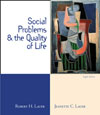 |  Social Problems and the Quality of Life, 8/e Robert H. Lauer,
U.S. International University
Jeanette C. Lauer,
U.S. International University
Violence
Internet Exercise- How is violence generated? Is violence "bred into the bone"? Do
fundamental cultural patterns such as ethnocentrism encourage violence against
outgroups? Or, in more purely sociological terms, can we trace violent behavior
to structural arrangements in the social order? Begin your exploration into
these sorts of questions by going to the Sociosite Website. (http://www.pscw.uva.nl/sociosite/index.html)
From the Sociosite home page, select "Subject Areas." In the search
window at the bottom of that page, enter the word "Violence" and proceed.
Select "Sociocite: Chad Joseph McEvoy-Sociology" and read two articles
by Dr. McEvoy: "The Evolution of Emotion, Urge, and Behavior" and
"Ethnocentrism and Xenophobia as Biologically Adaptive Traits."
- Using your own words, define ethnocentrism and xenophobia, and give an example
of each.
- How does Dr. McEvoy view free will in human behavior?
- What does Dr. McEvoy mean by "genetic bias" with respect to such
things as racism?
- How does Dr. McEvoy relate our emotions and feelings to our ideals of moral
behavior?
- To reflect on structural causes of violence (beyond what you have learned
from your text), go to the My Virtual Reference Desk Website. (http://www.refdesk.com/)
Enter "violence + media" in the Google search window and hit "GO."
On the second page of the listed source options, select the "RMMW: Statement
on TV News and the Culture of Violence" and read the article "TV News
and the Culture of Violence," by Paul Klite.
- Critically evaluate Mr. Klite's article. Do his arguments make sense to
you?
- What specific recommendations does Mr. Klite endorse for reducing the impact
of the media on the culture of violence?
- How, in Mr. Klite's view, does our attraction to violence in the media reflect
sadism?
- According to the Rocky Mountain Media Watch, what percentage of newscast
content is devoted to violent content?
|
|



 2002 McGraw-Hill Higher Education
2002 McGraw-Hill Higher Education